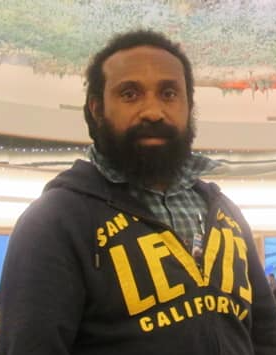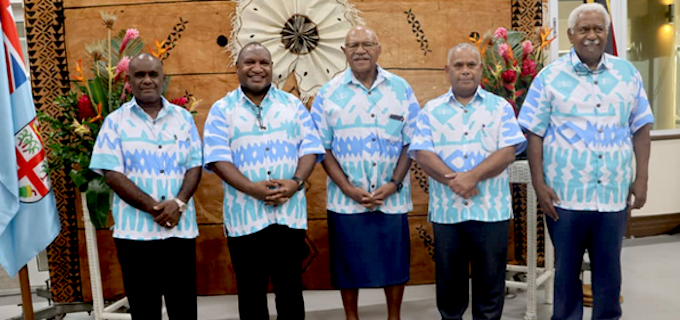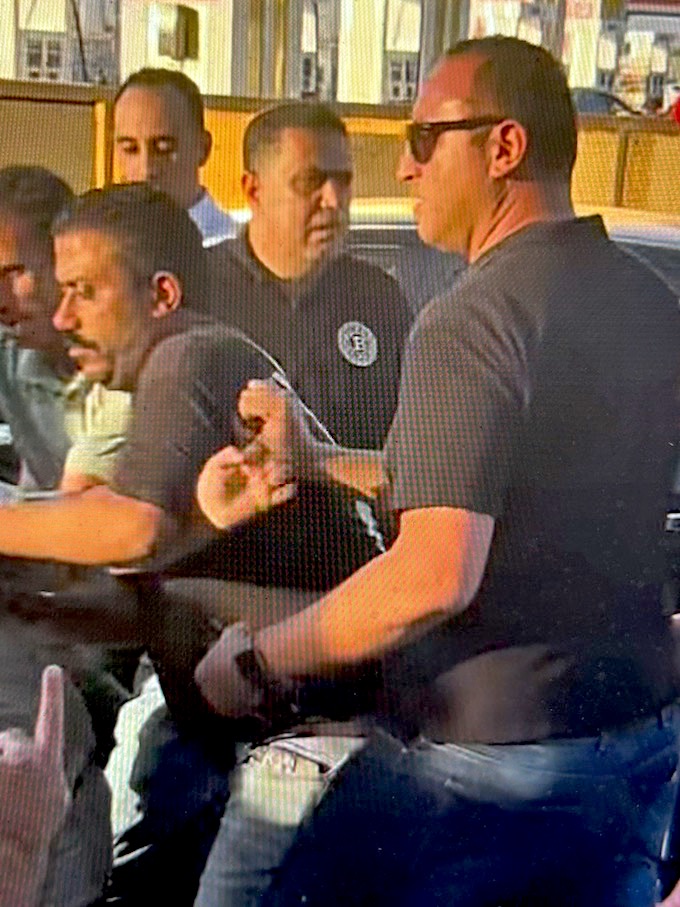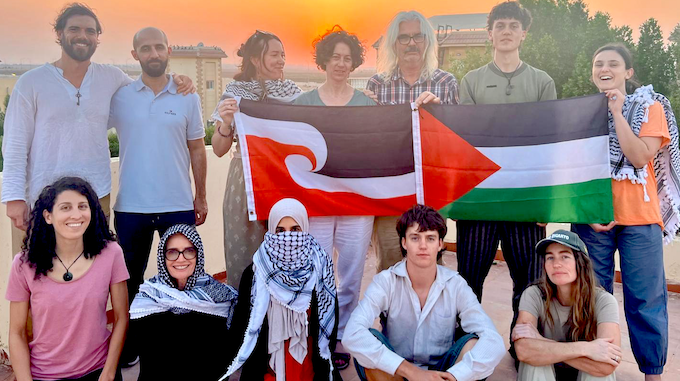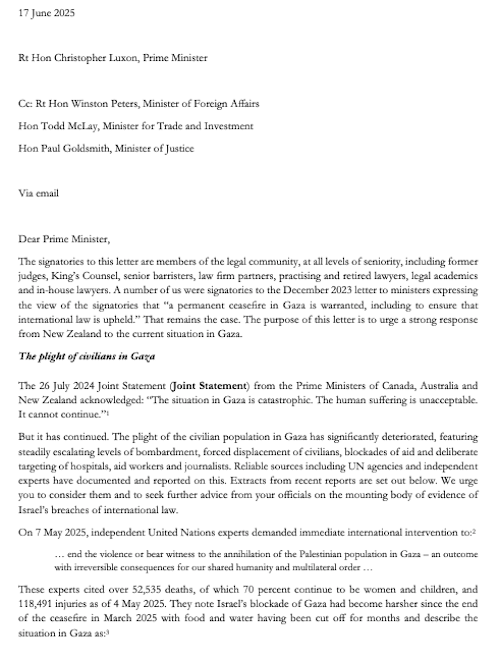Michelle Taylor sat at the defense table during her sentencing hearing in St. Augustine, Florida, listening to a trio of forensic chemists lay out the scientific evidence to prove what she’d sworn for years: She had not set the fire that burned down her house and killed her own son.
It was the last Friday in May, and the St. Johns County courthouse was mostly empty.
The expert witnesses each testified via Zoom, their faces appearing on a pair of large monitors inside the wood-paneled courtroom. None of the experts knew Taylor personally. But they knew chemistry. And each made clear that the case against Taylor had been based on junk science: faulty analysis by a state lab worker who detected gasoline in fire debris samples where there was none.
The testimony was vindicating for Taylor. But it also came too late to prevent what she insisted was a wrongful conviction. More than six years after the fire, she had reluctantly accepted a plea deal at the urging of her defense attorney. It allowed her to maintain her innocence — and avoid a mandatory life sentence had she gone to trial and lost. But it had not cleared her name. Now Taylor hoped the hearing might.
Taylor’s home caught fire on the night of October 23, 2018. She and her 18-year-old daughter Bailey escaped through a window. But her 11-year-old son David went back for the family dog and died. Investigators became immediately suspicious of Taylor after a dog trained to detect accelerants alerted in several spots throughout the home. At the state fire marshal lab outside Tallahassee, fire debris analyst Dee Ann Turner examined samples collected from the scene and repeatedly found gasoline, a telltale sign of arson.
But Turner was disastrously wrong, the witnesses said. According to the experts, she had misidentified gasoline in 12 different samples taken from Taylor’s home. The samples were “very clearly not gasoline,” testified John Lentini, a renowned fire scientist who first reviewed the data and submitted his findings in a defense report in January 2024. Turner’s erroneous analysis had gone undetected for so long because investigators had little reason to suspect such sweeping mistakes — “nor did they have the expertise to question it,” he testified.
The faulty forensics became the basis for the entire case against Taylor, Lentini said. “Every time another possibility was considered, the [lead investigator] said, ‘Yeah but we’ve got gasoline here.’”
Prosecutors had long known that their forensic evidence was fatally flawed. Lentini’s report had been reviewed by a pair of chemists with the federal Bureau of Alcohol, Tobacco, Firearms, and Explosives, who agreed that the data did not show gasoline. Yet Seventh Judicial Circuit State Attorney R.J. Larizza had refused to drop the charges against Taylor, instead seizing on financial improprieties in her bank records as proof that she committed arson for profit. Taylor and her husband were behind in their mortgage at the time of the fire. Despite having money to pay for it, there was evidence that Taylor had defrauded area churches to cover the payments instead.
Such circumstantial evidence did not prove anything on its own. But Taylor’s attorney, John Rockwell, worried it may be enough for a jury to convict his client anyway. He worked out a plea deal with prosecutors, who agreed to drop the arson charge if Taylor pleaded no contest to manslaughter. Rockwell, a former prosecutor, began to prepare for the sentencing hearing the way he would for a criminal trial. If he could prove that the scientific evidence did not hold up, he could convince the judge to impose the lowest possible sentence.
The stakes remained high. Under the plea deal, Seventh Judicial Circuit Judge Lee Smith could still sentence her to as many as 13 years in prison. And while the scientific evidence was certainly on Taylor’s side, there was no guarantee Smith would be moved by it. At the start of the hearing, Lee asked Taylor: “And you still want to proceed today with the sentencing knowing the possible range of possible sentences that you’re facing?”
“Yes, sir,” Taylor said.
No Gray Area
I first wrote about Taylor in March, delving into the fire investigation in her case as well as the Florida lab, which had a record of faulty fire debris analysis. At that time, Taylor was scheduled to go to trial over the summer — and prosecutors had asked the judge to limit what Lentini would be allowed to say to the jury about the lab, arguing that its history was irrelevant.
Lentini had been raising alarm over the lab for years. The lab’s flawed gasoline findings had led numerous people to be wrongly accused of arson — including in a death penalty case. In 2016, he filed an ethics complaint against the lab, which led to an audit by a team of independent experts. The results were abysmal: Of 26 cases they selected for reanalysis, lab analysts had wrongly reported gasoline in 14 of them. The lab temporarily lost its professional accreditation but regained it after agreeing to a remedial plan, which included a self-review of work dating back to 2009. But the review was never completed, leaving some 8,000 cases unexamined.
“There is no gasoline in these samples.”
At the heart of the problem, Lentini argued, was that state lab analysts were not following the professional standards for fire debris analysis that had been in place for decades. Rules for identifying ignitable liquids in fire debris were developed in the 1990s by the American Society for Testing and Materials. A standard known as ASTM E1618 laid out specific parameters for identifying gasoline. The auditors had previously found that lab analysts were not following the standard, instead using an “unvalidated protocol that is not generally accepted in the scientific community.” Although the lab claimed to abide by ASTM E1618, Turner’s work showed that, in Taylor’s case, this was not true.
In a statement to The Intercept, a spokesperson for the Florida Division of Criminal Investigations’ Bureau of Forensic Services said: “BFS adheres to industry standards, including ASTM E1618, to detect trace levels of ignitable liquids and ensure reliable, science-based conclusions. Moreover, the lab maintains a culture of continuous improvement, regularly evaluating its procedures, investing in advanced training, and participating in proficiency testing to uphold the highest integrity of its work.”
The evidence taken from Taylor’s home in the fall of 2018 had gone through a common procedure for testing fire debris. Samples were collected in metal cans, which were brought to the lab and heated in an oven. The resulting vapors were captured on charcoal strips suspended from the top of each can, which were then rinsed with a solvent, producing a solution to be injected into a machine called a gas chromatograph/mass spectrometer. The GCMS, as it is commonly known, produced a chromatogram: an electronic signature made of up peaks and valleys.
This process is straightforward until it comes to interpreting the data. The peaks on a chromatogram that indicate gasoline can easily be mistaken for peaks indicating other petroleum-based products. For this reason, ASTM E1618 dictates that lab analysts start their examination by ensuring there are five specific peaks on a chromatogram, which must appear at certain ratios in order to be labeled positive for gasoline.
According to Reta Newman, a veteran chemist and one of the independent auditors who uncovered problems at the state lab in 2016, the samples in Taylor’s case had not passed this first step. Testifying at the sentencing hearing that afternoon, she agreed with Lentini’s blunt assessment. “There is no gasoline in these samples,” she testified.
“There is no gasoline in these samples.”
Newman, the director of the Pinellas County Forensic Lab, gave a quick chemistry lesson. “Gasoline is a blended product,” she explained, full of components that are added to improve performance in internal combustion engines. These include a class of hydrocarbons known as aromatic compounds, which are ubiquitous in petroleum-based products, including materials used to furnish modern homes. Newman motioned toward the green courtroom carpet as an example. When such synthetic materials burn in a fire, they “unfortunately break down into aromatic products — the same compounds that we see in gasoline.”
On a chromatogram from a gasoline sample, aromatic compounds form a specific pattern that can be hard to differentiate from those produced by aromatics in burned synthetic materials. “Fortunately for us,” Newman said, there is another kind of hydrocarbon that analysts use to identify gasoline in a fire debris sample. “I apologize for being so nerdy. But isoalkanes are also added to gasoline,” she said. And unlike aromatics, isoalkanes generally do not turn up in burned synthetic material.
Turner had correctly identified aromatic compounds in the fire debris taken from Taylor’s home, Newman said, although the peak patterns “were much more consistent” with the burning of synthetic material rather than gasoline. But the data showed an absence of isoalkanes. Under ASTM E1618, this should have been disqualifying. Yet Turner had reported the samples positive.
Rockwell, Taylor’s attorney, asked whether this was a plain fact or a subjective opinion. “If two different scientists look at this, is it very easy to tell that this is either gasoline or not gasoline?” he asked. Newman acknowledged that many cases present samples where there are gray areas. But not here. “There is no gray area.”

The third and last expert witness for the defense was Laurel Mason, a veteran chemist and director of a Georgia lab called Analytical Forensic Associates. Unlike Lentini or Newman, who had only reviewed Turner’s reports and chromatographic data, Mason had actually reexamined the carbon strips used to test the fire debris from Taylor’s home. She found no proof of gasoline or any other ignitable liquid.
There was a haunting irony to Mason’s testimony. She had actually first encountered Taylor’s case in 2018, when one of her lab analysts had examined fire debris samples taken from the home on behalf of Taylor’s homeowner’s insurance company. That analyst found no evidence of an ignitable liquid. The insurance investigator concluded that the cause of the fire was undetermined — and Taylor’s insurance company paid the claim in full. Had Mason been the analyst first assigned to examine the evidence on behalf of the state rather than the insurance company, Taylor would almost certainly have never been arrested for arson.
Mason had found a number of things alarming about Turner’s work. There was the analysis itself, which was clearly flawed. But she was also concerned about the lab’s handling of evidence. Rockwell had asked for permission to retest the carbon strips after discovering that the fire debris samples themselves had been destroyed by the lab. But the lab resisted providing the strips, offering instead to cut them in two and allow the defense to test one half of each. Posting on a listserv for fire debris analysts in late January, Turner had solicited recommendations for any scientific literature that might support this plan. She was not successful, perhaps because, according to Mason, altering the carbon strips went against best practices for preserving evidence.
Rockwell asked Mason about a strange turn of events that followed her examination of the carbon strips. Shortly after Mason submitted her defense report in February 2025, Turner herself issued an amended report on behalf of the state lab, suddenly altering four of her original findings without explanation. Of the samples she had originally determined to be positive for gasoline, four were now negative. “The curious thing to me was the documentation,” Mason testified. On the data sheet accompanying the report, where Turner had crossed out four of the original findings, she had written her initials, along with the date: February 26, 2025. Yet the report itself was dated January 2025.
To Rockwell, it seemed clear that the amended report had been deliberately backdated to make it appear as if it had preceded Mason’s report — a stealth correction designed to circumvent any accountability for the lab’s mistakes.
The lab did not respond to specific questions about the backdated report, but said in a statement its “technicians are extensively trained and conduct rigorous reviews of their findings, often re-examining evidence in preparation for depositions or expert testimony.”
Whatever the truth of the timing, it was clearly unusual for an expert to go back and change their conclusions six and a half years later. “I have never seen that before,” Mason said.
“I Hope This Can Be Corrected”
In a teal blouse and freshly colored hair, 41-year-old Taylor listened to the expert testimony without expression. She’d lost weight since her last court date, the effect of stress, according to her most vocal advocate Megan Wallace, who Taylor had met at the county jail, and who wept in the back of the courtroom for much of the hearing.
Taylor’s arrest had made her a villain in the press. Yet almost no local media had shown up at the hearing. Though a TV reporter sat in the jury box alongside a cameraman, her subsequent report would make no mention of the flawed forensics at the center of the case.
Taylor’s husband Dennis and their daughter Bailey sat in the front of the gallery. The fire and its aftermath had torn their family apart. Dennis’s mother Lillian had blamed Taylor for David’s death, telling a police detective in an interview that she believed her daughter-in-law had set the fire for insurance money. But she had since disavowed her statements. In an email to the judge, she wrote, “I strongly disagree and contradict anything I said,” adding that she was “heavily medicated” at the time. “I hope this can be corrected and we can have a satisfactory outcome and closure to all parties involved.”
Other family members had written character letters on Taylor’s behalf, along with friends, neighbors, and co-workers who described Taylor as generous, hardworking, and completely committed to her children. David’s football coach described Taylor as “the most supportive and involved parent,” sharing an anecdote about David I had previously heard in my interviews. “I vividly remember moments in the middle of games when he’d run over to give her a kiss, not caring if his teammates saw,” he wrote. “Their bond was pure and inspiring.”
Several of the letters begged the judge to let Taylor go free. Although her supporters understood the plea deal in theory, they could not comprehend why she should serve any more time behind bars for a crime she did not commit.
Representing the state was Assistant State Attorney Sarah Thomas, who flatly rejected the notion that Taylor was innocent, telling the judge at the start of the hearing that prosecutors had agreed to the plea deal because they did not believe she had meant to kill her son. Thomas called a series of witnesses whose brief testimony seemed mainly aimed at casting Taylor in a suspicious light, from a uniformed sheriff’s deputy who said that Taylor had told Bailey not to speak to investigators at the hospital on the night of the fire, to a fraud expert who described the scam Taylor appeared to have been running against local churches — including, it turned out, his own.
With no witness to discredit the scientific testimony of the defense experts, Thomas instead sought to reframe the problem. It wasn’t that the lab had reported gasoline where there was none, she suggested. Rather, the necessary components in the contested samples were simply too low to fulfill the “threshold” necessary to report it as gasoline. This was highly misleading; as the experts had testified, the fire debris samples were actually missing the necessary components to be accurately classified as gasoline. And the whole purpose of a standard is to ensure accurate interpretation of forensic evidence. If the indicators were too low to report gasoline, a sample had to be classified as negative.
Nevertheless, Thomas cast this as a mere technicality. She called the former K-9 handler whose accelerant detection dog had alerted at the site of the fire — and who explained that just because a dog’s alerts are not always confirmed by a lab analyst, it does not mean that there is nothing there. “The lab has a level that they have to meet,” he said. “The experts will tell you that what the dog is picking up is below what they can call by their standards. It is gasoline. Everyone at the lab people kept telling us, ‘It is gasoline but it does not meet our level to be able to call it that for court.’”
Thousands of Samples
The last person to testify for the state was Dee Ann Turner herself. Her name had been visible on the TV monitors since the start of the hearing, suggesting that she’d heard the defense experts’ critiques of her work and would be well-positioned to respond. But this was not the case. “I’ve been sitting waiting to be let in,” she chuckled.
Turner had worked at the lab for a decade. She was hired in 2015, the year before the lab temporarily lost its accreditation. As the state’s sole scientific expert, she was the only witness who could conceivably rehabilitate the state’s case against Taylor. Instead, her testimony was unpersuasive and off-putting. She was awkward and halting, fumbling basic questions and laughing at uncomfortable moments. When Thomas asked when she submitted her amended lab report — a critical chance to clear up any suspicions that it had been purposefully backdated as Rockwell claimed — Turner shuffled clumsily through her paperwork for more than two minutes. She finally answered that she submitted the report in January 2025, explaining that her notes were dated February 2025 because she’d forgotten to date and initial them.
Thomas asked Turner why she had gone back to revise her 2018 findings to begin with. “After reading Mr. Lentini’s deposition I went back and looked at the data,” Turner replied. “I decided, you know, this data really isn’t sufficient for a positive call.”
The answer seemed to catch the prosecutor off guard. Thomas had cast Lentini as hopelessly biased — a man with a “vendetta” against the state lab. Now her own expert was saying that Lentini’s opinion had prompted her to reexamine her own work. In her closing argument, Thomas would go on to insist that, in fact, Turner had changed her findings on the basis of the other experts, who were more worthy of respect — never mind what Turner herself said on the stand.
On cross-examination, Rockwell probed further into the question of what had prompted Turner to revisit her analysis from 2018. Did anything change about her approach to fire debris analysis between 2018 and 2025? Turner said that the lab’s reporting requirements had become stricter after its accreditation was temporarily suspended. “We’re being more conservative in our calls,” she said. But Rockwell pointed out that the accreditation had been suspended and restored in 2016. Turner’s analysis in the case had taken place two years later. Turner was forced to concede that, in fact, nothing had changed.
Rockwell asked Turner if she was aware of Laurel Mason’s retesting of the carbon strips. Did it surprise her that Mason found no proof of an ignitable liquid in the fire debris samples? Yes, “I’m actually quite surprised,” Turner said. Would it surprise her to know that Reta Newman, “one of the preeminent authorities in the fire debris chemistry field also has the same opinion as Mr. Lentini and Ms. Mason?” Yes, Turner said. “I’m surprised by that as well.”
Rockwell pointed out that, in a total of 22 samples she’d examined in the case, Turner had reversed her determinations in four. This came out to 18 percent. Wasn’t this an unacceptable error rate for an expert like her? Turner hesitated. “It’s not wrong,” she said. “I still think that there’s gasoline in those samples that I changed. It’s just — the data’s just not sufficient for me to report it.”
Rockwell asked the question again, over the objection of the state. When her lab analysis is used by investigators “to arrest somebody for first-degree murder and arson, when that can change the course of someone’s life forever, do you think that’s an appropriate standard of error?” he asked.
“No,” Turner finally said.
Still, she objected to the characterization of her work. “This is one case,” she said. Over the course of her career, “I’ve analyzed thousands of samples.”

The Most Important Evidence
The last round of testimony came from Taylor’s family. Her mother tried to read a letter to the court but left the stand after becoming too emotional, leaving Rockwell’s co-counsel to read it instead. Bailey and her father, Dennis, both spoke briefly, holding their emotions at bay. But the trauma of the fire and its aftermath was written on their faces.
When Taylor stood to address the court, her words quickly gave way to anguished sobs. She talked about her three children, one of whom had died in a tragic accident just a few years before David. In the months leading to the fire, she said, her grandmother had died of cancer, which had led to Taylor’s financial problems. “When she didn’t have the money, I used my money,” she said. “I would’ve gave her every last dime I had to save her life.” Above all, she wanted the judge to know that she did everything she could to save David from the fire. “I lived for my son.”
Before delivering his closing argument, Rockwell flagged one last piece of evidence for the judge: a polygraph test given to Taylor in early May. Taylor had been asked three variations of a single question: Did she set a fire in her home in October 2018? Taylor had passed every time.
Polygraphs have long been known to be unreliable and thus inadmissible in criminal trials. Although the rules of evidence governing the sentencing hearing were different, Thomas was suddenly concerned about junk science, objecting to the polygraph, and arguing that the judge had to find “some reliability of the evidence” before it could be introduced. But Smith said that the polygraph results had been included in the binder he’d received prior to the hearing. She had not objected then. Besides, he said, “I’ve already reviewed it.”
In his closing, Rockwell called the case “the most difficult case I think I’ve ever worked on in my career.” He decried Turner’s laughter and “cavalier attitude” upon being confronted with her errors. Thomas countered that Turner’s laughter had been due to nerves, blaming Rockwell for pummeling her with the same question over and over again. She reiterated that Lentini was too biased to be believed. But when Smith asked Thomas whether she had any response to the other experts — or to the ATF chemists who had agreed with Lentini more than a year earlier — the prosecutor had little to say.
Smith was quiet for a few moments, then cleared his throat. “The most important piece of evidence, I think, in any arson case is the science,” the judge said. He was not an expert himself, he added, and declined to say which side was correct. But he was going to impose the lowest sentence: three years in prison, with credit for time served.
Taylor was taken into custody moments later. She embraced her lawyers, thanking Rockwell profusely, then hastily took off her watch to give to her family with the rest of her belongings before being handcuffed. Her mother asked a sheriff’s deputy permission to give her a hug but was denied.
On June 11, Taylor was transferred to the Florida Women’s Reception Center in Ocala. In an email this week, she said she would discuss her case after she gets out of prison, which should be in a matter of weeks given the nearly three years she spent in jail. She is scheduled for release in August.
The post Top Scientists Debunked the Arson Case Against Michelle Taylor. She’s in Prison Anyway. appeared first on The Intercept.
This post was originally published on The Intercept.






